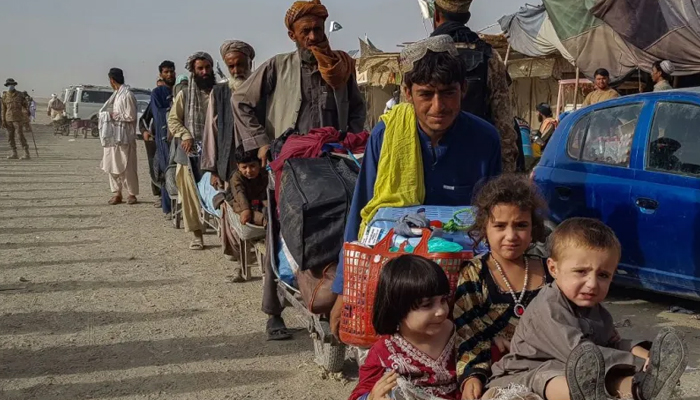A sudden change of heart and policy
The issue of refugees is not new in Pakistan. Since its inception, the country has faced challenges in accommodating refugees from across the borders and even from faraway countries such as Myanmar.
The first major influx of refugees started at the time of the partition of India and from Bengal and Punjab to Sindh, nearly all administrative units had to receive refugees in different proportions.
After 1947, a majority of Muslims from Bihar in India migrated to East Bengal, a majority of Punjabi Muslims from East Punjab moved to West Punjab and mostly Gujarati and Urdu-speaking Muslims migrated to Sindh, settling in Hyderabad, Karachi, Khairpur, Mirpur Khas, and Sukkur. It is hard to determine how many of them were migrants and how many refugees as some of them migrated by choice and others by compulsions of circumstances and unfolding adverse events for them in their native towns and villages. The United Nations uses distinct definitions of migrants and refugees.
For the uninitiated here is the difference per the UNHCR website: “A refugee is someone who has been forced to flee their home country because of persecution, war or violence. A refugee has a well-founded fear of persecution for reasons of race, religion, nationality, political opinion or membership in a particular social group. Most likely, they cannot return home or their lives would be put at risk. Some of the leading causes of violence that force people to flee their countries are war and ethnic, tribal and religious violence.”
For migrants there is no formal or legal definition – mostly it refers to a person who changes his or her country of usual residence irrespective of the reason for migration. It may be for short-term or temporary migration of a few months. or for long-term or permanent migration to change a country of residence for better life opportunities by choice. So it appears that the essential difference is not of duration but of choice. One may become a migrant for any reason but one is a refugee only by compulsion.
Now, this also creates some issues of judgment. What is the level of compulsion that forces one to migrate or take refuge? At the time of Partition, there were massacres in Punjab, so those Hindus, Muslims, and Sikhs who had to flee might rightly be refugees. But there were many who willingly and voluntarily opted for Pakistan without any clear and present danger of a massacre. They appear to be migrants by choice and not refugees by compulsion as there were millions of Muslims who remained in India and did not move.
So this remains a moot question. Talking about Biharis who refused to take up Bangladeshi citizenship in expectation of migrating to Pakistan but preferred to remain in refugee camps in the newly created country, the question is even more complicated. They have been living in refugee camps for over half a century now. The same applies to Palestinians who were definitely refugees and had to flee for their lives and have been living in camps for decades. And now we come to the most recent issue of Afghan refugees in Pakistan.
After the 1979 invasion of Afghanistan by the Soviet Union, there was a major influx of Afghans to neighbouring countries – mostly to Iran and Pakistan. Most of them moved by choice as there were no reports of mass massacres by the invading troops. The new Afghan government had started taking over land from big landlords and giving it to small farmers. Then there was massive propaganda against the new government declaring it to be anti-Islam and many gullible people fell into the ruse that the US and its allied used against the communist threat.
The third and the most ruthless military dictator in Pakistan, Gen Ziaul Haq, was in need of international support so he gladly opened borders to welcome Afghan migrants and refugees, as they included both willing and unwilling people leaving their homes. Iran did not allow the Afghans to move across the country and kept them within the confines of their camps.
Afghans in Pakistan could acquire education, buy properties, establish businesses, and run transport companies across Pakistan. Demographic composition changed not only in the bordering provinces of Balochistan and Frontier (now Khyber Pakhtunkhwa) but also in Sindh, mostly in Karachi. Helping a nation in need is a noble act, but allowing that nation to transform your country is another.
By the 1990s, the Soviet forces had withdrawn from Afghanistan but the likes of Gen Hameed Gul were never at rest. Supporting favourite militant groups and hoping to establish a ‘friendly government’, the doctrine of ‘strategic depth’ did more harm to the region in the 1990s than the Soviet forces had done in the 1980s. The Afghans settled in Pakistan could hardly move back till fin de siècle (end of the century) when a new ruthless regime of the Taliban was in near complete command of Afghanistan, prompting even more refugees to pour in.
After the invasion of Afghanistan by the US and installation of the Karzai government, there was a noticeable repatriation of Afghans back to their country but a resurgence of the Taliban in the late 2000s dashed all hopes of any massive shift. In the second decade of the 21st century, there were efforts on the part of both the US and the EU to funnel huge amounts for the reconstruction of Afghanistan and for strengthening the Afghan government that Ashraf Ghani was leading after Hamid Karzai. Thousands of scholarships granted to Afghan students resulted in a large number of foreign graduates who started contributing to rebuilding efforts in Afghanistan.
But the Taliban used their ‘strategic patience’ as the occupation forces lost their stamina and preferred to pull out after 20 years as compared to just 10 years of the Soviet occupation. The failure of the US was not entirely unconnected with the ‘assets’ and ‘proxies’ operating in the region. From the then establishment to the then prime minister Imran Khan, all were ecstatic at the US withdrawal and the Taliban takeover in Kabul. Now Afghanistan has found itself once again under the yoke of the Taliban’s regressive regime that Pakistan hoped would manage to control cross-border terrorism.
From August 2021, there has been a renewed influx of Afghans who can’t live under the Taliban. The decision of the government of Pakistan to expel Afghans not having valid documents has prompted civil society organizations in the country to raise their voice against this hasty expulsion. After hosting Afghans of various stripes for decades, suddenly there is a change of heart that is resulting in more hardships for Afghan refugees. The Human Rights Commission of Pakistan in its recent consultation in Islamabad has called for a more circumspect approach rather than giving a knee-jerk reaction.
All refugees – new or old – possess certain rights that must be respected. An open-door policy in force for over 40 years cannot lead to a sudden shift to a closed-door policy of expulsion. Each case deserves specific assessment and humanitarian consideration must prevail.
The writer holds a PhD from the University of Birmingham, UK. He tweets/posts @NaazirMahmood and can be reached at: mnazir1964@yahoo.co.uk
-
 Enjoy Lee, Takaichi’s Viral Jamming Session, In Case You Missed It
Enjoy Lee, Takaichi’s Viral Jamming Session, In Case You Missed It -
 MrBeast Admits He's Unsure About Having Kids - Here's Why
MrBeast Admits He's Unsure About Having Kids - Here's Why -
 Prince Harry Carries Heartbreaking Hope For Archie, Lilibet Who Are Not Sharing In Their Royal Heritage
Prince Harry Carries Heartbreaking Hope For Archie, Lilibet Who Are Not Sharing In Their Royal Heritage -
 Tom Brady Breaks Silence On 'personal Life' After Alix Earle Rumors
Tom Brady Breaks Silence On 'personal Life' After Alix Earle Rumors -
 Guy Fieri Drops Health Update After Accident That Left Him In A Wheelchair
Guy Fieri Drops Health Update After Accident That Left Him In A Wheelchair -
 Experts Weigh In: Is Prince Harry Operating A PR Stunt Or The Invictus Games’
Experts Weigh In: Is Prince Harry Operating A PR Stunt Or The Invictus Games’ -
 Inside Kate Middleton’s Biography With Secrets From St Andrews To Harry & Meghan’s Royal Exit
Inside Kate Middleton’s Biography With Secrets From St Andrews To Harry & Meghan’s Royal Exit -
 Paul Mescal Reveals Shocking Move He Made In 'Hamnet'
Paul Mescal Reveals Shocking Move He Made In 'Hamnet' -
 'Kanye West Is Human Too'
'Kanye West Is Human Too' -
 Prince William Hands Kate Middleton Something Highly Sensitive To Manage With Coronation
Prince William Hands Kate Middleton Something Highly Sensitive To Manage With Coronation -
 Critics Get Honest About 'A Knight Of The Seven Kingdoms'
Critics Get Honest About 'A Knight Of The Seven Kingdoms' -
 Why Harry Unlikely To Meet William, Kate During UK Return?
Why Harry Unlikely To Meet William, Kate During UK Return? -
 X To Change AI Chatbot 'Grok' After Outrage Over Explicit Deepfake Images
X To Change AI Chatbot 'Grok' After Outrage Over Explicit Deepfake Images -
 Princess Eugenie Set To Hit New Milestone As Andrew's Eviction Looms
Princess Eugenie Set To Hit New Milestone As Andrew's Eviction Looms -
 Emilia Clarke Gets Honest About Featuring In Shows Like 'Game Of Thrones'
Emilia Clarke Gets Honest About Featuring In Shows Like 'Game Of Thrones' -
 Amazon Employees’ Break-time Fight Ends In Murder In Texas
Amazon Employees’ Break-time Fight Ends In Murder In Texas




